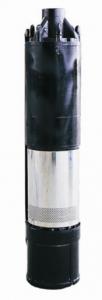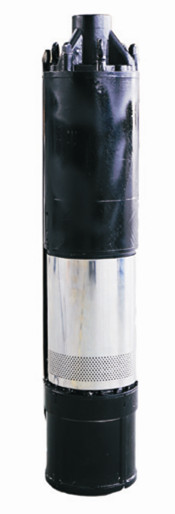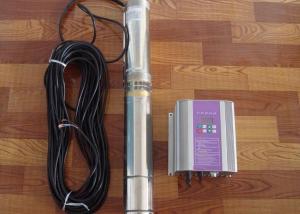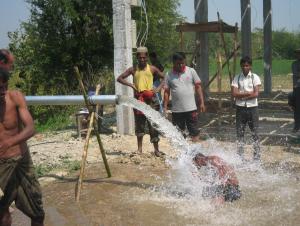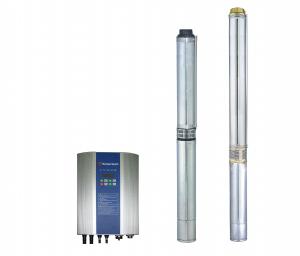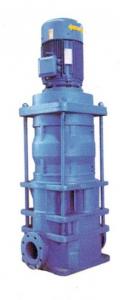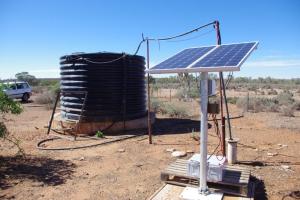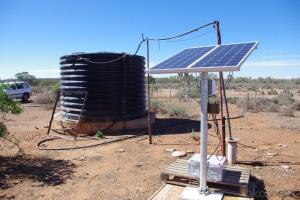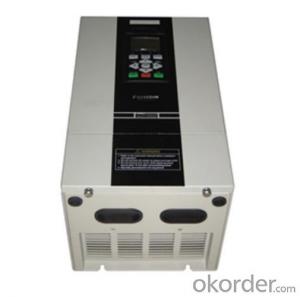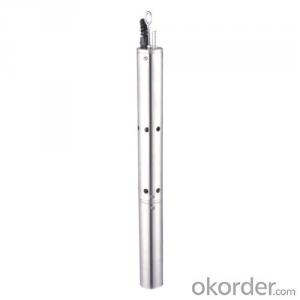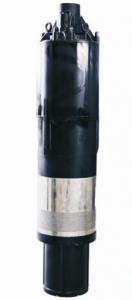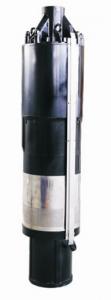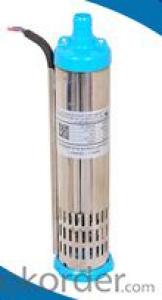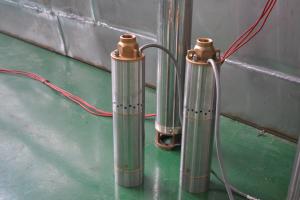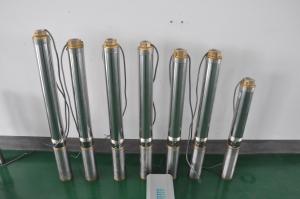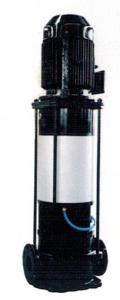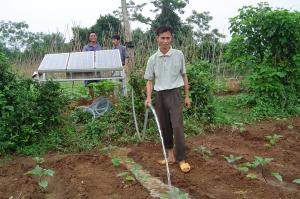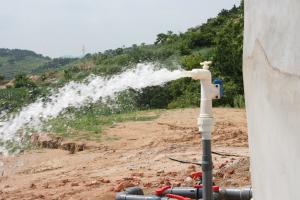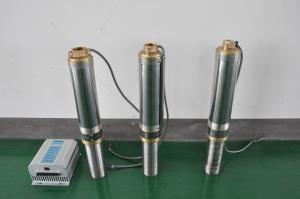Solar Water Pump 3ds-6-100 for Waterfall Feature
- Loading Port:
- China Main Port
- Payment Terms:
- TT OR LC
- Min Order Qty:
- -
- Supply Capability:
- 300 sets /month
OKorder Service Pledge
OKorder Financial Service
You Might Also Like
Product description:
Product: Solar water pump
Model:3DS-6
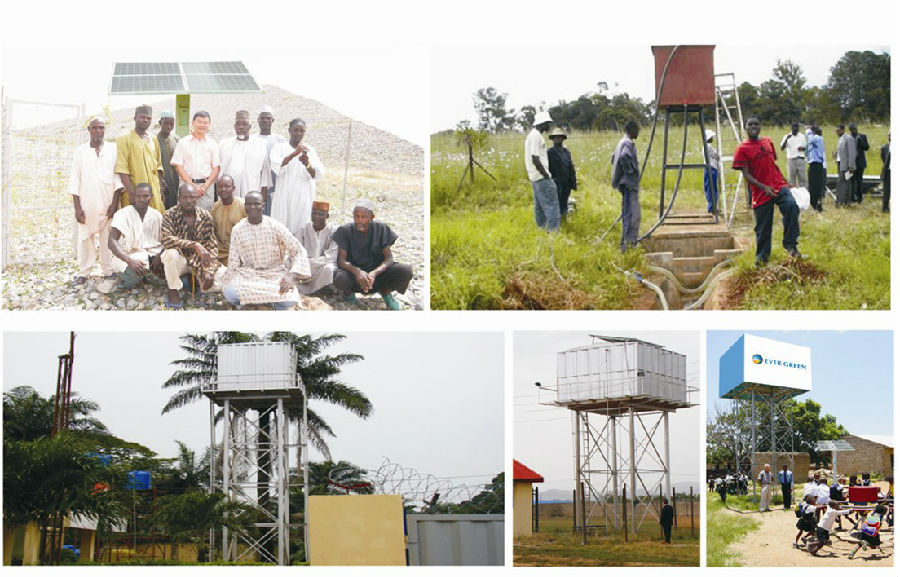 Appilication:
Appilication:
submersible pump
for deep well near a village or small farm
for drinking water of one village (100-300 people)
for watering a small farm
Product specification:
flow rate:500 liter/ hour, 4000m3/day.
lift: 70m-100m
pump diameter: 140mm
well diameter more than 150mm
with BLDC motor, motor power:600W
but only need solar power:230W, our pump can save more than 50% solar panel power.
Material:
Pump inside: stainless steel and wearable nylon,it enables our solar pump to have 10 years sevice life.
Motor length:15cm,80% shorter than other motors. So that you can pump 80% more water by our solar pump.
Certification:
3 International patent
ISO9001
CE
Warranty:2 years
- Q: Are there any limitations to the type of water a solar pump can handle?
- There are certain restrictions when it comes to the type of water that a solar pump can handle. One constraint is the presence of debris or sediment in the water. Generally, solar pumps are engineered to manage clean water, and if the water contains a large amount of debris, it can lead to the pump becoming clogged or damaging its components. Another limitation is the level of salinity in the water. Although solar pumps can handle water with some salinity, there is a threshold beyond which the pump's efficiency may decrease or it may suffer damage. The specific tolerance for salinity can differ depending on the type and model of the solar pump. Furthermore, the temperature of the water can also impact the performance of a solar pump. Extreme temperatures, whether excessively hot or cold, can affect the pump's efficiency and lifespan. Solar pumps are typically designed to endure a specific range of temperatures, and operating outside of this range can cause problems. Lastly, the depth of the water source can also be a restriction. Solar pumps are generally suitable for shallow water sources, such as wells or ponds. If the water source is too deep, the pump may not be capable of efficiently lifting the water to the desired height. In conclusion, it is crucial to consider these limitations and ensure that the type of water and its conditions align with the specifications of the solar pump being used. Consulting the manufacturer's guidelines and recommendations can provide more specific information regarding the limitations of a particular solar pump model.
- Q: How much maintenance is required for a solar pump?
- Solar pumps require minimal maintenance compared to traditional pumps. The main maintenance tasks include ensuring the panels are clean and free from debris, checking the connections for any loose wires, and periodically inspecting the pump for any signs of damage or wear. Overall, the maintenance requirements for a solar pump are minimal, making them a cost-effective and hassle-free option for water pumping.
- Q: How does a solar pump handle water with high levels of organic matter or decaying materials?
- A solar pump can effectively handle water with high levels of organic matter or decaying materials by using a filtration system. The pump is equipped with filters that can remove solid particles and debris from the water, preventing clogging or damage to the pump. Additionally, some solar pumps have self-cleaning mechanisms that help to prevent any build-up or blockage caused by organic matter.
- Q: Can a solar pump be used for irrigation in arid regions?
- Yes, a solar pump can definitely be used for irrigation in arid regions. Since arid regions receive abundant sunlight, solar pumps can efficiently harness solar energy to power water pumps, providing a sustainable and cost-effective solution for irrigation. These pumps can draw water from various sources like wells, rivers, or underground reservoirs, and distribute it to the fields, enabling farmers to irrigate their crops even in water-scarce areas. Solar pumps offer a reliable and environmentally friendly alternative to traditional diesel or electric pumps, making them well-suited for irrigation in arid regions.
- Q: Can a solar pump be used for water supply in off-grid eco-resorts?
- Yes, a solar pump can be used for water supply in off-grid eco-resorts. Solar pumps are a reliable and sustainable option for water supply in remote locations where grid electricity is not available. They harness solar energy to power the pump, making them environmentally friendly and cost-effective in the long run. Additionally, solar pumps can be easily installed and maintained, making them a suitable choice for off-grid eco-resorts aiming to minimize their carbon footprint and operate sustainably.
- Q: Are there different types of solar pumps available?
- Yes, there are different types of solar pumps available, including submersible solar pumps, surface solar pumps, and solar-powered water fountain pumps.
- Q: How does the energy usage of a solar pump system vary with different pumping depths?
- The energy usage of a solar pump system generally increases with deeper pumping depths. As the depth increases, the pump needs to work against higher water pressure, resulting in increased energy requirements. However, it is also important to consider the efficiency of the pump system, as more efficient pumps can minimize the energy consumption even at greater depths.
- Q: Are there any government incentives or subsidies for installing a solar pump?
- Yes, there are government incentives and subsidies available for installing a solar pump. Many governments around the world recognize the importance of renewable energy and the benefits of utilizing solar power for water pumping systems. These incentives and subsidies aim to encourage individuals, businesses, and organizations to adopt solar pumps as an environmentally friendly and sustainable alternative to traditional pumping systems. The specific incentives and subsidies available may vary by country or region, but they typically include financial assistance, tax credits, grants, and low-interest loans. For example, in the United States, the federal government offers a federal investment tax credit (ITC) that allows individuals and businesses to deduct a percentage of the cost of installing a solar pump from their federal taxes. Some states may offer additional incentives on top of the federal ITC. Furthermore, various international organizations, such as the World Bank, also provide funding and support for solar pump installations in developing countries. These initiatives aim to improve access to clean water and enhance agricultural productivity in areas where electricity supply is unreliable or non-existent. It is advisable to consult with local government agencies, energy departments, or renewable energy associations to get detailed information about the specific incentives and subsidies available in your area. By taking advantage of these government programs, individuals and businesses can significantly reduce the upfront costs of installing a solar pump and contribute to the transition towards a more sustainable future.
- Q: Are there any safety considerations for solar pump installations?
- Yes, there are several safety considerations for solar pump installations. Firstly, it is important to ensure that the solar panels are installed correctly and securely to prevent any potential hazards. This includes proper grounding and protection against lightning strikes. Additionally, the wiring and electrical connections should be done by a qualified professional to avoid any electrical hazards. It is crucial to follow the manufacturer's guidelines and local electrical codes to ensure a safe installation. Furthermore, it is essential to protect the solar pump system from overheating. This can be achieved by providing adequate ventilation and shading to prevent excessive heat buildup. Moreover, regular maintenance and inspections are necessary to identify any potential issues or malfunctions that could pose safety risks. This includes checking for loose connections, damaged components, and any signs of wear and tear. Lastly, it is important to have proper signage and safety precautions in place to warn individuals of the potential hazards associated with the solar pump system. This can include signage indicating high voltage areas, safety barriers, and clear instructions on how to safely operate and maintain the system.
- Q: What is the maximum operating temperature of a solar pump?
- The specific model and manufacturer can cause the maximum operating temperature of a solar pump to vary. Nevertheless, most solar pumps are engineered to function in temperatures ranging from -40°C to 60°C (-40°F to 140°F). It is crucial to acknowledge that surpassing the maximum operating temperature can potentially harm the pump components and diminish its efficiency. Hence, it is advisable to thoroughly contemplate the environmental conditions and guarantee the implementation of adequate ventilation and cooling strategies to avert overheating of the solar pump.
Send your message to us
Solar Water Pump 3ds-6-100 for Waterfall Feature
- Loading Port:
- China Main Port
- Payment Terms:
- TT OR LC
- Min Order Qty:
- -
- Supply Capability:
- 300 sets /month
OKorder Service Pledge
OKorder Financial Service
Similar products
Hot products
Hot Searches
Related keywords
